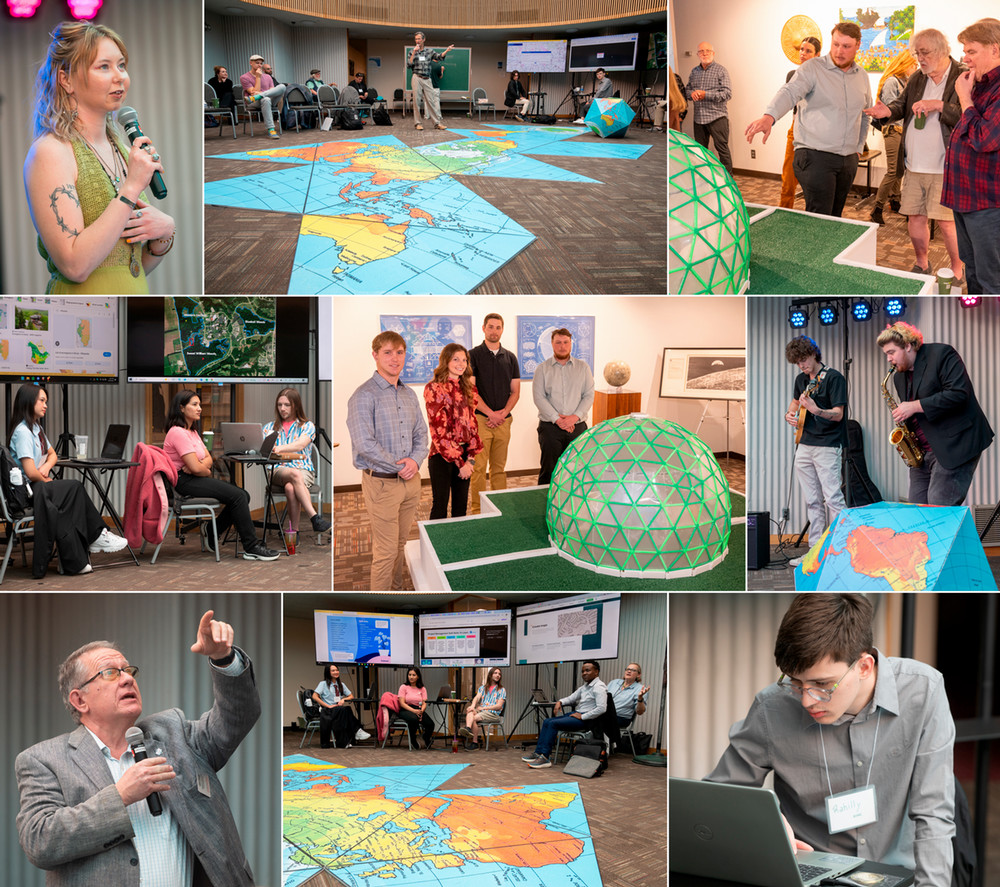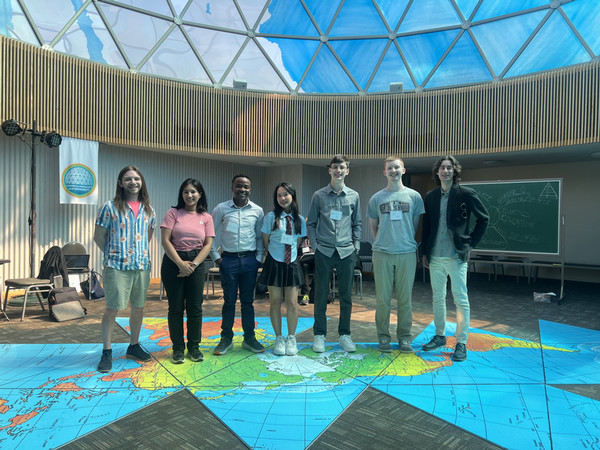Ecology Enthusiasts from Across the Globe Assemble on SIUE’s Campus to Collaborate and Celebrate the Legendary Inventor Buckminster Fuller
The Fuller Dome Presents Five-Day Conference, 90th Day Programs

The man with an ingenious ecological and humanitarian idea that became a movement, caused his concepts to travel around the world and earn him the title, “Father of the Modern Sustainability Movement.” The pioneering legacy of the renowned visionary inventor R. Buckminster Fuller was applauded and his theories and beliefs revisited and discussed during a five-day conference at the Fuller Dome, Center for Spirituality and Sustainability (CSS) on the campus of Southern Illinois University Edwardsville, according to CSS Manager Tovia Black.
The Fuller Dome observed 90th Day programs that began Thursday, March 27 and culminated on Monday, March 31, the 90th day of the year on the planet’s 90th meridian. The event was supported by the SIUE Chancellor’s Office.
The Fuller Dome’s miniature-earth geodesic dome was designed by Fuller, a Southern Illinois University professor from 1959-1975, to straddle the planet’s 90th longitudinal meridian as it passes through the SIUE campus. Fuller referred to this idea of a miniature-earth building as a “Geoscope” and his dome on the SIUE campus is the only built example of this concept, according to CSS Director Benjamin Lowder.
Fuller had another large-scale idea for the SIUE campus.
“We came across a proposal that Fuller had written in which he proposed to build a World Resource Simulation Center for the SIUE campus in the late 1960s,” said Lowder. “He envisioned that the interior of it would convey data about global population distribution and global resource distribution to come up with solutions and strategize to make the world work for 100% of humanity through what he called ‘spontaneous cooperation without ecological offense or disadvantage.’”
To fund it, Fuller’s proposal was written up in an Illinois House bill. But it never passed. A small-scale version of the proposed center was on display at the conference. It was constructed by Peter Meisen, of San Diego, who moderated several conference sessions.
Another one of Fuller’s inspired designs was the “Dymaxion” map that he made and patented in the 1940s, a term that he coined and for which he is credited. “It is a world map with no distortions,” said Lowder, who assembled a replica that laid on the floor of the main Dome room during the conference. “Why have the country of Greenland the same size as Africa? How can we address the global challenges without an accurate picture of the world?”
Hundreds of people from across the globe streamed in and out of the Dome during the conference, all seeking ecological solutions through collaborations, according to Lowder.
“I’m somewhat encouraged. I’m ready to work hard on this stuff,” said a jovial George Orbelian, of San Francisco, Calif., after one of the sessions. “We can make this happen! We have all the solutions. The only thing that is holding us up is Washington, D.C.”
“We can reverse the erosion,” continued Orbelian. “There is a guy named Kongjian Yu, who devised the concept of ‘Sponge Cities’. He has about 1,000 projects in China and has been doing this for 28 years. Then there is John D. Liu who has 80 ecosystem restoration communities around the world, where he has taken destroyed ecosystems and is bringing them back to thriving, healthy ones and people are living and eating off them. Then there is Ron Finley, the ‘Gangsta Gardener’ of Los Angeles. These are just some of so many good things happening around the world.”
Glenn Page of Portland, Maine, said he was drawn to attend the summit to further collaborate to address pressing environmental matters.
“This is a meeting of how we navigate this incredibly uncertain future ahead,” said Page, of the Collaborative for Bioregional Action Learning & Transformation (COBALT). “I’m here because this is the work that we do, and we need to learn and work together.”
“Yesterday, we looked at the way some of these domes were made in the area,” added Page. “We went to the Mary Brown Neighborhood Center in East St. Louis (a geodesic dome that functions as a gymnasium and was constructed by the late Janfrey Preston of East St. Louis). I played basketball there. I had a blast. It’s about coming together with the community. It begins in the head, but it must work through the heart and move down to our will. What are we going to do?”
Collective dreaming will help in dealing with ecological matters, according to Juliana Bohorquez, of Valle de Zaquencipa, Colombia. “It’s more difficult not to dream. Destruction takes more effort,” noted Bohorquez, an artist who works with Page at COBALT. “But we are more related to destruction than creation, because most of our knowledge is based in distinction and separation and not in unity.”
Bohorquez has built a dome in her hometown that is a bioregional hub for regeneration and spirituality. “I am the keeper of ancestral ceremonies and traditions,” she explained. “I grew up doing the vision quest and the Earth dance. All these traditions have signs based on sacred geometry, which is why I have always been very interested in Bucky (Buckminster).”
Fuller’s ideas grow more important with each passing day, said conference speaker SIUC alumna Elizabeth Donoghue, president of the Buckminster Fuller Dome Home Board in Carbondale, assistant director in the University Honors Program at SIUC.
“One of my favorite concepts of his is the idea of ‘livingry.’ It’s the opposite of weaponry,” said Donoghue after her slide presentation. “He thought that if you poured the resources into livingry that you did into weaponry, we wouldn’t be in this place that we are now. We all need to have an eye toward the betterment of all. He was so focused on building solutions and doing the work.”
Fuller’s message of doing the working for the betterment of all has impacted SIUC freshman Rahilly Machado, of Brazil, so much so, that he changed his life’s goal.
 “When I was a child, people thought I would be a scientist, and I thought that myself,” said Machado, a first-generation college student who is studying computer engineering. “I realized that humanity was able to solve problems enough to go to the moon, but we were not able to solve the problem of a child dying because they lack food. So, I decided that I would work on that.”
“When I was a child, people thought I would be a scientist, and I thought that myself,” said Machado, a first-generation college student who is studying computer engineering. “I realized that humanity was able to solve problems enough to go to the moon, but we were not able to solve the problem of a child dying because they lack food. So, I decided that I would work on that.”
“Going to space or creating a supercomputer is a meaningless problem, if another human is dying right now because they lack the basic survival needs,” added Machado. “And I am doing personal research to determine how to use my work to affect those who lack the most basic needs such as water and food.”
Some highlights during the five-day conference included:
- Katherine Dunham Style Dance Performance
- World Resource Simulation Center (with three SIUE students and three SIUC students researching and providing data and information from their computers in real time)
- Poetry Performance and Bucky Readings (with SIUE Jazz Trio accompanying the reading)
- Performance of the play, “R. Buckminster Fuller: THE HISTORY (and Mystery) OF THE UNIVERSE”
- World Peace Game
- Geometric Model Building
- Earth's Echo: Prayer for the Planet and Sing Along with Steph Plant
- Symposium on Fuller
The 90th Day programming was done in collaboration with the Buckminster Fuller Institute and the Estate of Buckminster Fuller.
The Fuller Dome, Center for Spirituality and Sustainability, is a miniature earth geodesic dome designed by Buckminster Fuller on land leased from Southern Illinois University Edwardsville (SIUE). Since 1971 the Dome has served the University and surrounding region as a place for multi-faith and interfaith gatherings. The Dome’s programing related to data visualization and cartography leverages Buckminster Fuller’s legacy at SIU by keeping his Geoscope, World Game and World Resource Simulation Center concepts active. The contact Fuller Dome email is fullerdome@outlook.com.
Photos:
SIUE and SIUC students, faculty and staff and conference attendees from around the world participated in the Fuller Dome’s five-day conference, 90th Day Programs, on the SIUE campus to honor world-renowned inventor R. Buckminster Fuller.
Composite picture
Top Row (L-R): Belle Scheller, Fuller Center Seekers (FCS) president, SIUE; Peter Meisen, World Resource Simulation and World Peace Game facilitator (center); Tom Kinsella, Fuller Dome board member (far left), and Steven Nungesser, SIUE senior (center pointing). Middle Row (L-R): Alliah Bombias, SIUC student; Shreya Acharya, SIUE student; and Torre Huffines, SIUE student; Grant Linton, SIUE student; Riley Middendorf, SIUE student; Alex Strebel, SIUE student; and Nungesser; Williams/Yablonski Jazz Duo: Colin Yablonski (on guitar) SIUE student; and Owen Williams (on sax) SIUE student. Bottom Row (L-R): Dr. John Cabage, SIUE Department of Construction chair, associate professor, and Fuller Dome board member; Bombias, Acharya, Huffines, Katja Kopp, Fuller Dome board member (vice president of Sustainability); and Kevin Ngowi, SIUE student; and Rahilly Machado, SIUC student.
Those participating in World Resource Simulation Center were students from SIUE and SIUC.
L-R: Huffines, Acharya, Ngowi, Bombias, Machado, Eli Collinsworth (SIUC student) and Vincent Arena, of New York.









